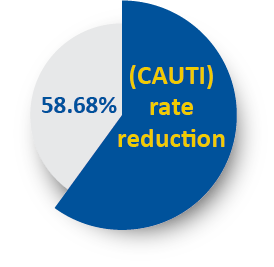The Centers for Medicare & Medicaid Services (CMS) Quality Improvement Organization (QIO) Program is dedicated to improving the quality of health care at the community level. Hospital Quality Improvement Contractors (HQICs) are strategic partners of the QIO Program that help hospitals improve outcomes in several patient-safety-related areas such as hospital-acquired infections (HAIs).
Convergence Health Consulting (Convergence) is one of nine organizations that CMS awarded a HQIC contract. To maximize their HQIC work with 300 hospitals in 11 states, Convergence subcontracts with regional and state hospital associations that have well-established relationships in their communities and serve all types of hospitals, healthcare systems, communities, patients and families. Convergence provides tools and resources the associations can use with hospitals to support the reduction of HAIs through a partnership with Cynosure Health and its Cynosure Learning Improvement Connection (CLIC) virtual learning platform.

One large Louisiana hospital successfully reduced Catheter-Associated Urinary Tract Infection (CAUTI) rates. In partnership with Convergence and the Louisiana Hospital Association (LHA), the hospital achieved a 58.68 percent reduction (percentage change baseline to performance) with a post-intervention period from 10/1/21 – 6/30/23.
To better understand their CAUTI rate, LHA provided the hospital with the Convergence CAUTI Discovery Tool to conduct their own mini root cause analysis. LHA, in collaboration with the Convergence infection control lead, reached out to the hospital for a virtual visit to ascertain what the hospital found through the analysis and what they were prioritizing. The analysis revealed opportunities to:
- Improve clinical documentation for appropriate indications, sterile techniques, proper catheter and peri-care
- Conduct two-person insertions
- Increase organizational knowledge of high-reliability tactics to improve patient outcomes
As a result, with HQIC tools and guidance, the hospital worked to implement the following interventions to reduce CAUTI infection rates:
Held daily device huddles – These short meetings are attended by nursing unit directors and hospital leadership and include a review of all devices, including Foley catheters. Attendees review the number of Foleys per unit, indications, and CAUTIs. Huddles increased transparency and accountability, elevated the importance of improving patient outcomes, and decreased the inappropriate use of Foley catheters. A Foley report is shared with staff that includes patient information, days inserted, indication/necessity and length of stay shared during daily device huddles.
Hired a device nurse – The device nurse is a dedicated expert in the hospital who assesses all devices using a daily Foley Device Report (see Figure 1) in the facility’s electronic health record (EHR). This assessment allows for the development of an escalation process to discontinue Foley catheters if needed. The device nurse provided CAUTI education to staff including Foley alternatives, such as external catheters and intermittent catheters, and with assistance from LHA, created tools such as Disrupting the Lifecycle of the Urinary Catheter Algorithm for nursing staff.
Figure 1. Example Daily Foley Device Report
Created CAUTI educational materials – A CAUTI Prevention PowerPoint, the Disrupting the Lifecycle of the Urinary Catheter Algorithm and Maintenance Bundle Easy Reference Guide were created for nursing staff to improve patient care. Working with LHA, the hospital initiated an updated Nurse-Driven Catheter Removal/Management of Urinary Retention Protocol that focused on educating, engaging, and empowering frontline staff to execute the protocol to improve patient outcomes. Additional resources from Cynosure Health’s CLIC learning platform such as a free resource course, Prevention of Catheter-Associated Urinary Tract Infections (CAUTI) (thinkific.com), the CAUTI Discovery Tool and the CAUTI Change Package were provided. Other no-cost patient safety courses such as Infection Prevention and CAUTI Improvement are also available to hospital staff.
Developed CAUTI prevention bundles – Two CAUTI prevention bundles, one for insertion and one for catheter maintenance, were created and built into the hospital’s EHR. An Insertion Audit Tool and a Maintenance Audit Tool were created by the hospital for the bundle elements. The Insertion Audit Tool documents if the indication was appropriate and aseptic techniques were used. The Maintenance Audit tool documents the following:
- How many days the Foley has been in?
- Was appropriate peri-care documented?
- Is the location of the bag (i.e., off the floor) appropriate?
- Is there an unobstructed drainage system?
- Is an approved securement device in place?
- What is the urine volume in the bag?
- Is a closed system maintained?
- Was catheter necessity discussed with the physician and what is the indication for use?
The infection preventionist and device nurse use these tools in their daily reviews of CAUTI cases.
Implemented a management protocol for difficult urinary catheterizations – This management protocol assists the nursing staff in focusing on bladder management of a patient with cervical or thoracic spinal cord injury or chronic urinary retention including neurogenic bladder. The nursing staff references this protocol when difficult insertions arise.
Keys to Success
Convergence’s success can be replicated by taking the following steps:
- Ensure tools and resources for preventing HAIs, such as the CAUTI Discovery Tool and the CAUTI Change Package are available to hospitals.
- Build relationships with hospitals through onsite visits, coaching calls, and outreach emails to provide support for HAI prevention.
- Encourage hospital senior leadership involvement to elevate the importance of infection prevention and improve patient outcomes.
For more information, visit Convergence HQIC.
This material was prepared by The Bizzell Group (Bizzell), the Data Validation and Administrative (DVA) contractor, under contract with the Centers for Medicare & Medicaid Services (CMS), an agency of the U.S. Department of Health and Human Services (HHS). Views expressed in this material do not necessarily reflect the official views or policy of CMS or HHS, and any reference to a specific product or entity herein does not constitute endorsement of that product or entity by CMS or HHS. 12SOW/Bizzell/DVA-1193-09/13/23

